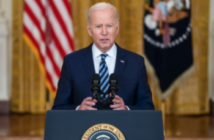Updated February 6, 2023 at 8:10 am
In a month, the Biden administration submit it’s defense budget request to Congress to continue to improve the nation’s military capabilities as Russia continues to wage war against Ukraine and to better deter China from sparking conflict in Asia.
While military investment is critical during a shrinking window of deterrence against Beijing, a bigger issue is the paralysis that often grips the Biden administration, the Pentagon and military leaders regarding major national security decisions.
What should be easy calls become subject to convoluted arguments to justify inaction.
After Moscow launched its illegal invasion of Ukraine, the administration exhibited initial reluctance to help Kyiv for fear of further provoking Russia, then quickly decided to provide Ukraine with unprecedented military and economic aid, and subject Moscow to unprecedented sanctions.
The White House deserves credit for marshaling the world to help Kyiv. But what Ukraine needs to actually win this conflict has consistently been too slow in coming, whether long-range artillery, air and missile defenses, military vehicles like tanks and combat aircraft, which continue to be denied. As former Pentagon comptroller Dr. Dov Zakheim rightly notes — the administration does the right thing, just too slowly, and that but better late than never isn’t a good long-term strategy.
Now, Russia is mounting an offensive before promised infantry vehicles and tanks arrive in Ukraine, underscoring the importance of timely decisions. Moscow is taking advantage of a window of opportunity that we gave them.
That’s the same case on sanctions — while looking great on paper — are being circumvented by Russia. Sanctions need to not only be targeted, but continually adjusted to ensure a desired effect. Against a massive country like Russia with lots of people and abundant resources, those sanctions need to be carefully crafted to inflict the pain necessary to drive desired change.
The consistent fear is whether Russia’s dictator, pushed too far, will make good on his nuclear threats.
Now, those same self-deterring tendencies were on full display as a Chinese spy balloon lazily steered its way over or by some of the nation’s most sensitive military sites, from Montana’s missile fields to Missouri’s stealth bomber base and to the Carolina coast, collecting intelligence it beamed back home while disrupting air travel.
President Biden said he ordered the balloon downed on Wednesday — as soon as the military deemed it was safe to do so. But it was only on Saturday that an F-22 fighter did so after the balloon was over the Atlantic. Nothing like shutting the barn door after the horses are gone to signal deterrence.
The episode appears to be the first time the United States has intercepted and downed a foreign asset for violating US airspace.
But for many, it will come as too little, too late, prompting Americans, whether they watch Fox or MSNBC, to ask: What is it that we’re getting from an $817 billion defense budget if our government has neither the capability nor the will to stop such a brazen violation of our sovereign airspace?
It’s a legitimate question.
On the one hand, the White House’s own strategy demands America better compete against China and urgently step up its warfighting game to better deter Beijing, something that Pentagon leaders are rightly doing.
Through its assistance to Ukraine, its ability to bring allies together, serve as the arsenal of democracy and toughness on China, the administration has built credibility worldwide as a security leader.
That progress, however, was undermined by failure of the White House, Pentagon and military leaders to down a reconnaissance craft from its leading adversary for a mish mash of incredible arguments — from fear of causing injuries and property damage; that the balloon isn’t a threat because China already has spy satellites — even as officials admitted they don’t know the mystery craft’s capabilities; or that the mission wasn’t condoned by Xi Jinping, but was a rogue effort by military hardliners to sabotage better relations.
All of which are utterly irrelevant. What mattered was the reality of a foreign reconnaissance asset that could have been intercepted and downed rather than allowed to cross the nation collecting intelligence.
Indeed, analysts suggest a slow-moving balloon at 60,000 feet — controlled by China and able to maneuver — could collect air samples, short-range communications and take more precise photographs than are possible from orbital systems.
In fact, the administration also disclosed that such violations have happened before, but also went unstopped. News reports maintain several such incursions happened during the Trump presidency.
No wonder Beijing concluded that even on the eve of a summit designed to charm Washington into easing its guard, it could get away with another incursion. Fortunately, Secretary of State Antony Blinken delayed his visit that would have included a meeting with Xi.
Had the balloon not have been reported by civilian aircraft, it’s possible this administration too might have ignored the episode to ensure Blinken’s trip to mend fences with China would proceed as planned. Increasingly in conflict with Russia over Moscow’s war against Ukraine, Washington wants to ensure that Beijing doesn’t help Putin and also dial down rising tensions.
Now, China is furious and threatening retaliation — an astonishing if unsurprising display of chutzpah after again being caught red-handed in its aggressive espionage efforts against the United States.
It’s worth remembering that in 2001, China intercepted a US Navy EP-3 reconnaissance aircraft over international waters, collided with it to force the four-engine plane to land, then held the crew hostage and stripped the airframe of all its sensitive electronics. Had Beijing detected an American reconnaissance craft over its territory, it would have promptly shot it down and proudly displayed the wreckage in Tiananmen Square.
The only possible justification for not destroying the Chinese balloon was over legitimate concern it contained a nuclear power source or other dangerous cargo that could have posed a broader danger if damaged. And if that was the case, there’s an obligation to tell the public. But officials maintained the craft posed no danger.
Still, with this single episode, the Biden administration and Pentagon delivered a troubling message — not even a territorial violation by an adversarial nation is enough to spur necessary action to signal such transgressions won’t be condoned in the future.
If you won’t defend your own territory from possible aggression, then you’re unlikely to risk your folks to defend someone else’s.
That’s a worrying signal to dozens of American allies and partners worldwide who depend on the United States for their security.
And precisely the message that Moscow and Beijing have long been making — you just can’t rely on Washington.
At a time of growing competition and conflicting narratives, a critical tool in Washington’s playbook is credibility. Each time Washington speaks, its messages must increase its credibility, not erode it.
Take just one of its assertions — that falling debris in the wake of a shoot down was a possible danger to lives and property. So better not do so over US soil.
When the Space Shuttle Columbia tragically disintegrated on re-entry in 2003 killing all seven astronauts aboard — scattering debris from Texas to Louisiana — not one person on the ground was injured, much less killed. And that was a 90-ton spacecraft traveling at hypersonic speed. The balloon may be three buses in diameter, but it’s payload is estimated at a quarter the size or less. And because of its slow speed, would have come down relatively vertically, limiting the debris field.
“I’m not an expert, but I can’t see why the government didn’t shoot the thing down,” Mayor Bill Cole of Billings, Mont., told the New York Times. “Montana only has seven people per square mile. The chance of hitting anyone is less than the chance of winning the Powerball.”
While ultimately, the balloon was destroyed, it should have been downed when it entered American airspace — not after leaving it. And not by blasting it out of the sky with an AIM-9X missile, but in a nuanced way to capture it as intact as possible over land, rather than taxing already scare undersea resources to retrieve debris from the bottom of the Atlantic.
This was an opportunity to demonstrate America’s ability to quickly and innovatively address novel threats.
Given the threat was a high-altitude balloon, the F-22 was the right plane for the job, able to fly high and also equipped with a gun that with a few rounds would have punctured the Chinese craft’s envelop enough to bring it down slowly.
That would have sent several important messages — we won’t tolerate a violation of our airspace, and we captured your reconnaissance system for study.
The key is to signal signal such violations are unacceptable. Doing so over the ocean might have been intended to demonstrate prudence, but may instead be regarded as confirmation of weakness.
America’s biggest challenge isn’t spending; it’s that leaders are time and again paralyzed by risk aversion. Paralyzed that they will either be seen as too provocative, or paralyzed by the notion that someone, anyone, might be hurt by what they do.
As a result, we make clear our priorities — a degree of risk aversion masquerading as prudence that encourages our adversaries to assume that they can easily game us unto inaction or buy time.




